
Bio
I have a passion for the preservation of the natural environment, a passion underpinned by a struggle of utmost importance, a struggle to find a balance between human needs and our ongoing existence with nature. This passion has led me to pursue a career as an academic. I completed an MSc degree in the field of aquatic health in my home country of South Africa where I conducted 'An assessment of the aquatic macroinvertebrate diversity within the Nyl River Floodplain system, Limpopo, South Africa'. I have recently obtained my PhD in Germany where I focused on 'Disentangling the effects of environmental drivers on the structure and function of macroinvertebrate communities within boreal streams'. Now, as a post-doctoral researcher, I find myself in Lithuania where my main aim is to integrate taxonomic, functional, and [phylo]genetic diversity through statistical and ecological explorations.
My intention as a scientist is to link the importance of conservation with that of aquatic systems because the animals and/or specific groups of organisms we find in these systems can aid in determining their quality and viability for human use and enjoyment. Questions about how and why global biodiversity is changing through time and space provide the foundation for my research. It is through integrative science that I believe I may further unlock the secrets of complex ecological systems and potentially elucidate how to protect them better.
Latest Publication
Recovery or reorganisation? Long‑term increases
in riverine taxonomic and functional diversity are
confounded by compositional dynamics
In our latest study, we delve into the long-term changes in Lithuanian riverine biodiversity from 2010 to 2020. While increased taxonomic and functional diversity suggests improvements in water quality, the rise of non-native species and shifts in species composition reveal a more complex narrative. Larger rivers, vital for both ecosystems and economies, highlight the pressing need to tackle global environmental changes, beyond water quality improvements. Understanding these dynamics is crucial for future conservation efforts.






